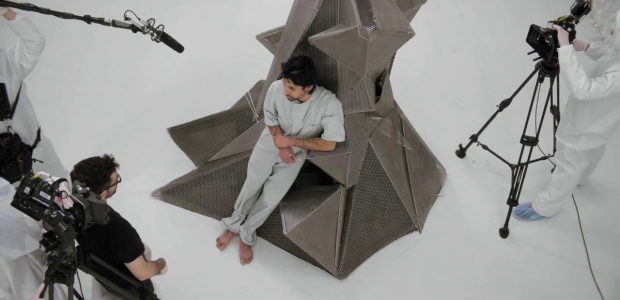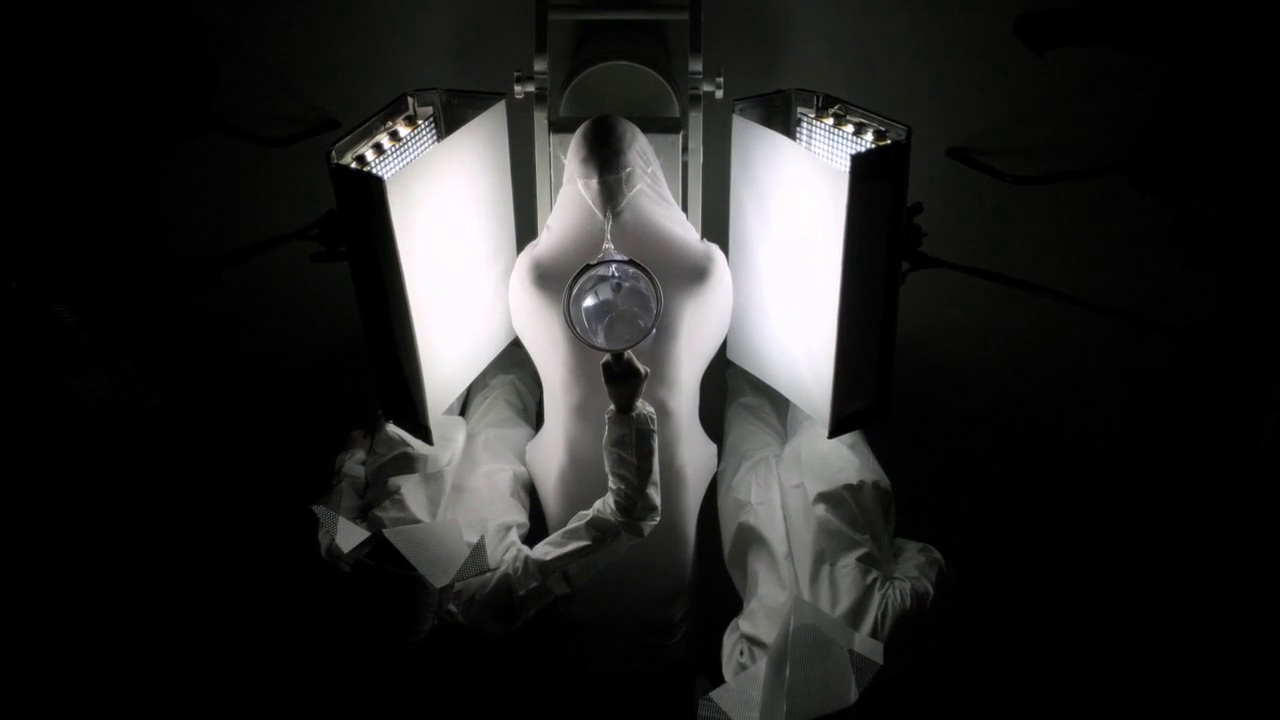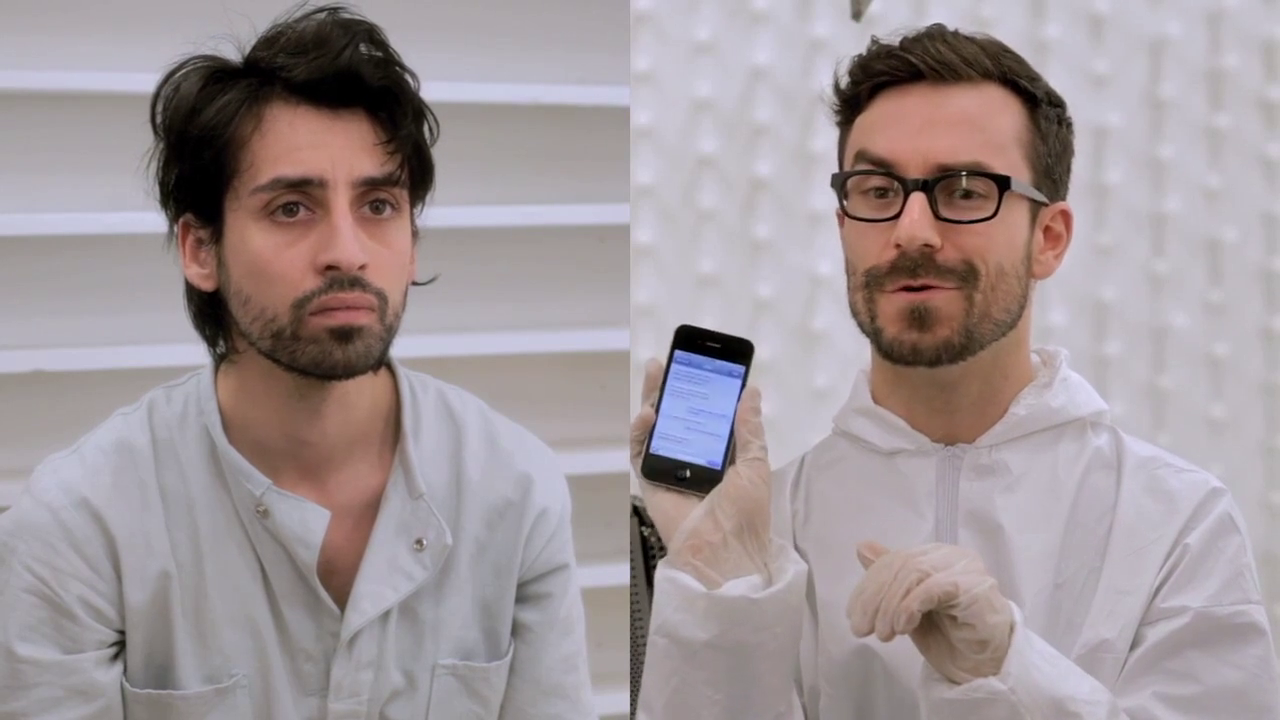A.J. Bond’s STRESS POSITION has one of those simple, basic concepts intriguing enough to be fantastic if the filmmaker fully embraces the potential for a great look at human nature. The set-up is simple – during a conversation about the treatment of Guantanamo Bay prisoners, two friends, A.J. (Bond himself) and Dave (David Amito) embark on a bet to see who can stand up to the other’s idea of torture with no serious physical harm for up to seven days. The bet is a high stakes affair, with $10,000 for the “winner” when the torturee reveals the password to a deposit transfer.
Don’t let the set-up of Guantanamo Bay fool you – it’s more an excuse to set up the premise rather than the questioning of anything political. It’s a negligible premise (and a fairly awkwardly-staged one), though it sets up the idea in the guise that it won’t be about human nature, but about the human nature of these two specific individuals, fictionalized versions of the actual people behind the acting masks. It’s a stark contrast to the likes of CUBE (the film STRESS POSITION most aesthetically resembles) or the recent THE HUMAN RACE where the characters in screen are stuck in a concept they had no part in devising – these are characters representing real human beings who have voluntarily created their own fates.
This may seem like a negligible difference, but it’s one that hovers over the entire running time of STRESS POSITION, as the torture games the two become involved in sometimes seem less like a depiction of what lengths human beings are willing to go through and more a cinematic therapy session for the players involved. Their interplay is also being filmed under the guise of making some sort of documentary with the assistance of mutual friend Marguerite (Marguerite Moreau, the sole other major character in the film), lending an even more insular nature to the proceedings and making the divide between fact and fiction even more wibbly-wobbly. (Where they get the money for all of this is unknown, but presumably anyone with $10,000 to throw around on an idle bet can afford to get together a crew and set for a couple of weeks.)
This isn’t to say that STRESS POSITION isn’t an interesting cinematic therapy session. Dave is up first, for reasons even he’s still unclear about, and A.J. places him alone in a small white room with only a steel piece of disjointed artwork as furniture. Dave’s clothes are stripped and replaced by a bland jumpsuit with his new name, Sheila. A.J. then continues to torture him to the best of his know-how – keeping him awake, forcing him to create a self-portrait of hair before he can use the primitive facilities – but his abilities are limited and he stoops to asking for help after a “tickle torture” fails to yield any results.
The stakes are raised from there, with A.J. becoming increasingly desperate to weaken Dave’s resolve, even bringing in Dave’s acquaintances to mention how he always puts his guard up and never feels “real.” It’s an attack on Dave’s performance skills, Dave playing at being Dave in order to not have to be the real Dave, or, in fact, David (the actor) portraying Dave (the character) portraying Dave (the strong face of the character) and being attacked for his acting ability through several levels.
STRESS POSITION doesn’t really keep to the standard template of simply exploring the concept as completely as it possibly can within a 90-minute timespan, a conceit clearly evident early in the film. It’s about torture only in that it explores what would be potential torture to these characters and how their relationship changes because of it – setting it in a stark locale with minimal flourish is more an exercise in aesthetic style for the sake of the film (or the film-within-a-film) than anything else. The torture sequences seem less like general, all-purpose torture the audience is meant to identify with and more the method used to inform the audience about these two “friends.” It’s a character study in the guise of a concept thriller, and that’s especially evident in the climax that feels more like a psychological breakthrough for the filmmaker than a fitting finale for a narrative film.
The film utilizes its examinations into its actors’ psyches admirably, exploring concepts like humiliation, self-doubt, internalized homophobia and parental disappointment to a deliberately uncomfortable degree, and Bond and Amito are impressively unrestrained in their performances. They may have bit off a bit more than they can chew with the meta angle, however, as the “film-within-a-film” concept never comes off, especially as scenes occurring “outside” of the torture room are depicted virtually identically to those inside – the use of a different format or heavier use of handheld camera would have helped make the concept a bit more convincing where it needs to be. STRESS POSITION certainly features an impressive look inside the room, though, again, the outside-the-room moments aren’t visually distinctive enough for the areas to feel sufficiently different.
Hirsute from A.J. Bond on Vimeo.
As a whole, STRESS POSITION doesn’t quite work, never staying “inside” long enough to be a creepy, clinical analysis of human extremes and not convincing enough to allow the self-referential aspects to work, and feels too insular for anyone who doesn’t already know Bond or Amito to fully engage with, but it’s certainly an ambitious film, featuring plenty of notable moments and enough inventive ideas to fill a half-dozen films. This is Bond’s first feature film (you can check out his similarly inventive short HIRSUTE above), and he’s certainly a talent to watch – if STRESS POSITION is anything to judge by, he’s a man was an impressively twisted vision that just needs to find the right template. Let’s hope he finds it.
@Paul Freitag-Fey
- [THE BIG QUESTION] WHAT’S YOUR FAVORITE FEMALE ENSEMBLE IN MOVIES? - July 22, 2016
- [IN THEATERS NOW] THE BOY (2016) - January 24, 2016
- Cult Movie Mania Releases Lucio Fulci Limited Edition VHS Sets - January 5, 2016









No Comments